活性自由基英文文献总结
- 格式:pptx
- 大小:195.92 KB
- 文档页数:11
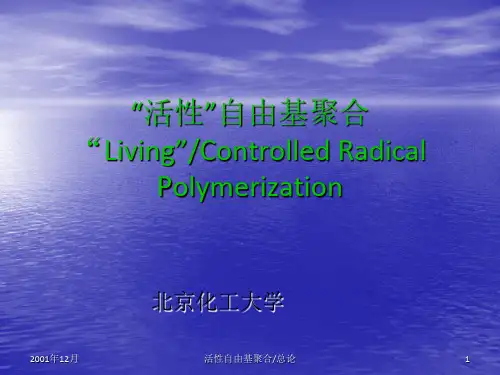
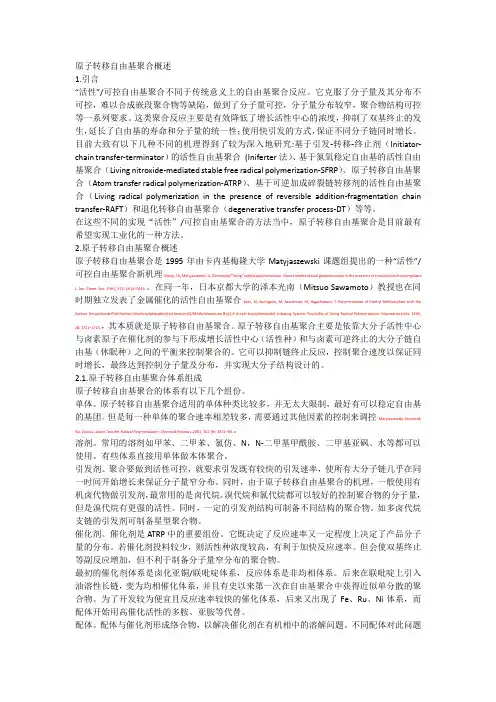
原子转移自由基聚合概述1.引言“活性”/可控自由基聚合不同于传统意义上的自由基聚合反应。
它克服了分子量及其分布不可控,难以合成嵌段聚合物等缺陷,做到了分子量可控,分子量分布较窄,聚合物结构可控等一系列要求。
这类聚合反应主要是有效降低了增长活性中心的浓度,抑制了双基终止的发生,延长了自由基的寿命和分子量的统一性;使用快引发的方式,保证不同分子链同时增长。
目前大致有以下几种不同的机理得到了较为深入地研究:基于引发-转移-终止剂(Initiator-chain transfer-terminator)的活性自由基聚合(Iniferter法)、基于氮氧稳定自由基的活性自由基聚合(Living nitroxide-mediated stable free radical polymerization-SFRP)、原子转移自由基聚合(Atom transfer radical polymerization-ATRP)、基于可逆加成碎裂链转移剂的活性自由基聚合(Living radical polymerization in the presence of reversible addition-fragmentation chain transfer-RAFT)和退化转移自由基聚合(degenerative transfer process-DT)等等。
在这些不同的实现“活性”/可控自由基聚合的方法当中,原子转移自由基聚合是目前最有希望实现工业化的一种方法。
2.原子转移自由基聚合概述原子转移自由基聚合是1995年由卡内基梅隆大学Matyjaszewski课题组提出的一种“活性”/可控自由基聚合新机理Wang, J-S; Matyjaszewski, K. Controlled/"living" radical polymerization. Atom transfer radical polymerization in the presence of transition-metal complexes. J. Am. Chem. Soc. 1995, 117: 5614–5615.。
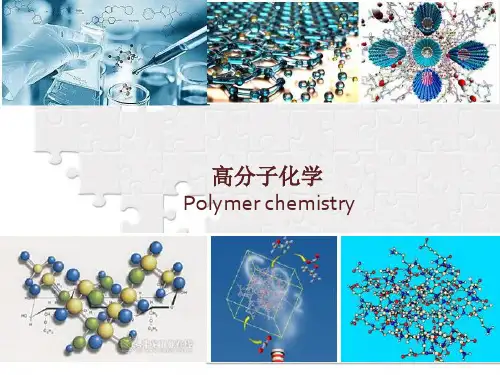
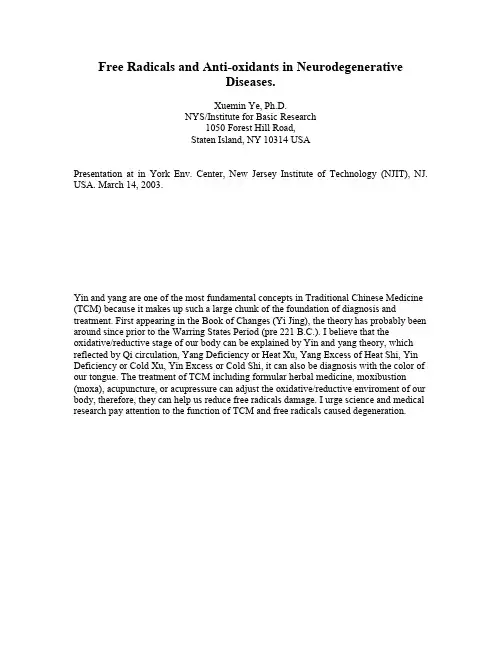
Free Radicals and Anti-oxidants in NeurodegenerativeDiseases.Xuemin Ye, Ph.D.NYS/Institute for Basic Research1050 Forest Hill Road,Staten Island, NY 10314 USAPresentation at in York Env. Center, New Jersey Institute of Technology (NJIT), NJ. USA. March 14, 2003.Yin and yang are one of the most fundamental concepts in Traditional Chinese Medicine (TCM) because it makes up such a large chunk of the foundation of diagnosis and treatment. First appearing in the Book of Changes (Yi Jing), the theory has probably been around since prior to the Warring States Period (pre 221 B.C.). I believe that the oxidative/reductive stage of our body can be explained by Yin and yang theory, which reflected by Qi circulation, Yang Deficiency or Heat Xu, Yang Excess of Heat Shi, Yin Deficiency or Cold Xu, Yin Excess or Cold Shi, it can also be diagnosis with the color of our tongue. The treatment of TCM including formular herbal medicine, moxibustion (moxa), acupuncture, or acupressure can adjust the oxidative/reductive enviroment of our body, therefore, they can help us reduce free radicals damage. I urge science and medical research pay attention to the function of TCM and free radicals caused degeneration.There are four basic properties that help to understand the relationship of yin and yangand make it easier to apply these prinicples to the microcosm that is the human body.1) The Opposition of Yin & YangYin and Yang are oppossite, however only relative to each other. Nothing is wholly yinor wholly yang. Each contains even the smallest of seeds of the other inside it. At anygiven time the two are in a constantly changing balance, with each vying for that one step ahead. Yang natured things (e.g., heat) counter and dispel yin natured things (e.g., cold)and vice-versa. If one predominates, it can overact on the other, cause imbalance and leadto disease.2) The Interdependence of Yin & YangYin and yang, though relatively opposite to one another, can not exist independently.They define each other, much as night and day do. One cannot know light without dark,or dark without light. They only exist in relation to the other. In addition, they feed off ofeach other. Yang is energy, and it needs nutrients to exert itself. Yin is nutrient and needs energy to form.3) The Mutual Consuming & Supporting Nature of Yin & YangBeing in a constant balance, yin and yang are constantly attempting to adjust to levels ofthe other. Outside influences may cause levels of one to either become significantlygreater or lesser than the other. Four possibilities can occur: Yang Deficiency or Heat Xu,Yang Excess of Heat Shi, Yin Deficiency or Cold Xu, Yin Excess or Cold Shi.There are two things to take note of here. The first is to pay attention to the heatand the cold attributes. Interchanging the words yang and yin with heat and cold respectively, plus combining with deficiency (xu) and excess (shi), you can get a rathergood sense how to apply this to the body imbalances. For example, yin deficiency canalso be thought of as cold deficiency. With a lack of cold in the body, false heat signs canbe seen. The second thing to note is the level of the non-deficient part of a xu/deficient condition. Since yin & yang draw off each other to exist, any deficient condition will cause a general deficiency of both yin and yang. For example, yin deficiency will alsohave a minor deficiency of yang that puts it just below its balanced level.4) The Intertransformation of Yin & YangThe dynamic balance of yin & yang is such that the two can transform into each other. Summer will eventually turn to winter, day will become night, even the most wild sugarrush will eventually lead to a resounding depression. The change is not spontaneous butneeds certain factors or precursors to exist. Internal factors are primary, yet externalfactors also have an effect. In addition, the timing of these things must be right. Considerthe transformation of matter to energy. The internal conditions of the composition ofmatter must be right and external factors must be applied at the right time for Massto multiply by C2 and cross over that equal sign to Energy (wonder where Einstein reallygot the notion of E=MC2 ?).叶学敏山东潍坊欣健生物科技有限公司Xye1630@。
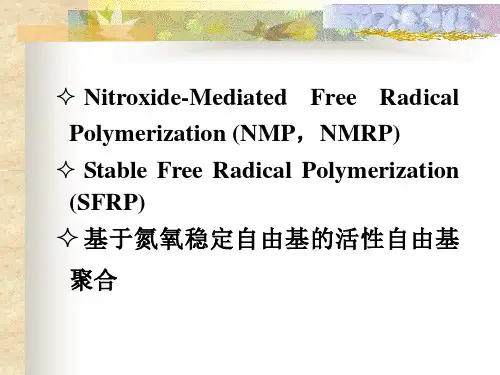
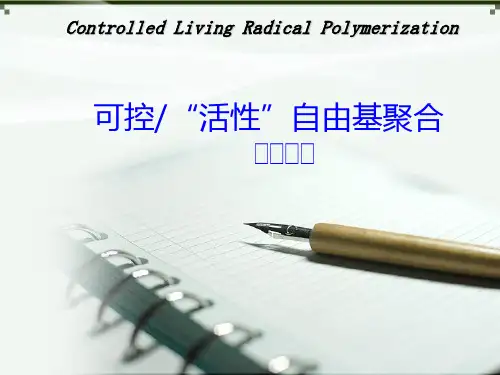
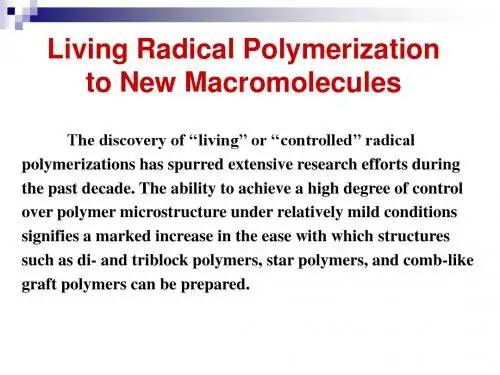
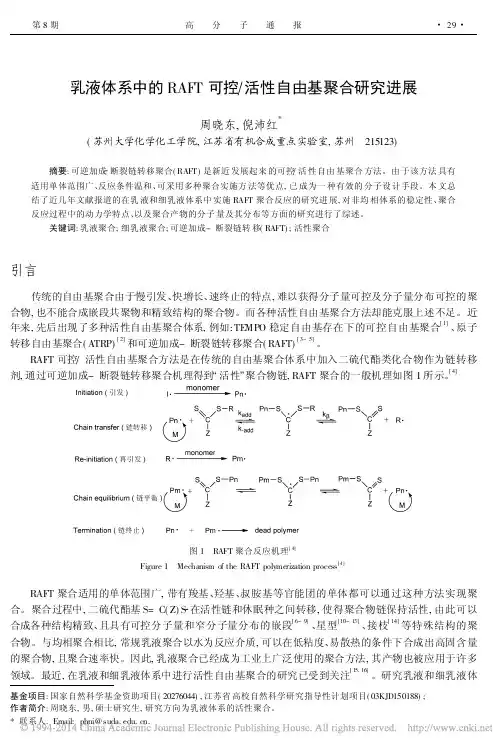
基金项目:国家自然科学基金资助项目(20276044),江苏省高校自然科学研究指导性计划项目(03KJD150188);作者简介:周晓东,男,硕士研究生,研究方向为乳液体系的活性聚合。
*联系人.Email:phni@.乳液体系中的RAFT 可控 活性自由基聚合研究进展周晓东,倪沛红*(苏州大学化学化工学院,江苏省有机合成重点实验室,苏州 215123)摘要:可逆加成 断裂链转移聚合(RAFT )是新近发展起来的可控 活性自由基聚合方法。
由于该方法具有适用单体范围广、反应条件温和、可采用多种聚合实施方法等优点,已成为一种有效的分子设计手段。
本文总结了近几年文献报道的在乳液和细乳液体系中实施RAFT 聚合反应的研究进展,对非均相体系的稳定性、聚合反应过程中的动力学特点、以及聚合产物的分子量及其分布等方面的研究进行了综述。
关键词:乳液聚合;细乳液聚合;可逆加成-断裂链转移(RAFT);活性聚合引言传统的自由基聚合由于慢引发、快增长、速终止的特点,难以获得分子量可控及分子量分布可控的聚合物,也不能合成嵌段共聚物和精致结构的聚合物。
而各种活性自由基聚合方法却能克服上述不足。
近年来,先后出现了多种活性自由基聚合体系,例如:TE MPO 稳定自由基存在下的可控自由基聚合[1]、原子转移自由基聚合(ATRP)[2]和可逆加成-断裂链转移聚合(RAFT)[3~5]。
RAFT 可控 活性自由基聚合方法是在传统的自由基聚合体系中加入二硫代酯类化合物作为链转移剂,通过可逆加成-断裂链转移聚合机理得到 活性 聚合物链,RAFT 聚合的一般机理如图1所示。
[4]图1 RAFT 聚合反应机理[4]Figure 1 Mechanism of the RAFT polymerization process [4]RAFT 聚合适用的单体范围广,带有羧基、羟基、叔胺基等官能团的单体都可以通过这种方法实现聚合。
聚合过程中,二硫代酯基S=C(Z)S 在活性链和休眠种之间转移,使得聚合物链保持活性,由此可以合成各种结构精致、且具有可控分子量和窄分子量分布的嵌段[6~9]、星型[10~13]、接枝[14]等特殊结构的聚合物。
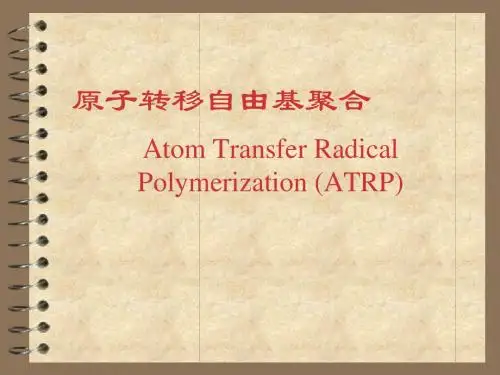
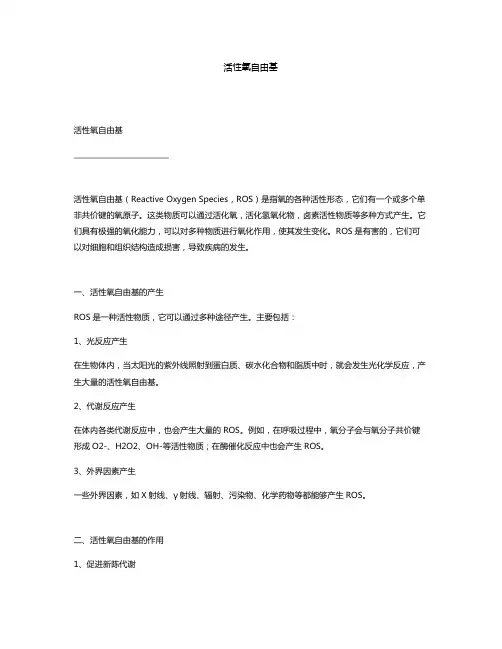
活性氧自由基活性氧自由基__________________________活性氧自由基(Reactive Oxygen Species,ROS)是指氧的各种活性形态,它们有一个或多个单非共价键的氧原子。
这类物质可以通过活化氧,活化氢氧化物,卤素活性物质等多种方式产生。
它们具有极强的氧化能力,可以对多种物质进行氧化作用,使其发生变化。
ROS是有害的,它们可以对细胞和组织结构造成损害,导致疾病的发生。
一、活性氧自由基的产生ROS是一种活性物质,它可以通过多种途径产生。
主要包括:1、光反应产生在生物体内,当太阳光的紫外线照射到蛋白质、碳水化合物和脂质中时,就会发生光化学反应,产生大量的活性氧自由基。
2、代谢反应产生在体内各类代谢反应中,也会产生大量的ROS。
例如,在呼吸过程中,氧分子会与氧分子共价键形成O2-、H2O2、OH-等活性物质;在酶催化反应中也会产生ROS。
3、外界因素产生一些外界因素,如X射线、γ射线、辐射、污染物、化学药物等都能够产生ROS。
二、活性氧自由基的作用1、促进新陈代谢ROS不仅能够产生新的物质,而且还可以促进新陈代谢,使生物体保持健康。
例如,ROS可以促进血液循环,增强免疫力,促进新陈代谢,并使机体能够更好地抵御外来侵害。
2、参与细胞信号传导ROS在细胞信号传导中也扮演着重要的角色。
它们可以影响细胞分裂、凋亡和存活,还可以促进器官的再生和修复。
3、诱导DNA修复ROS能够诱导DNA的修复,使DNA能够恢复正常的功能。
它们还能帮助DNA识别和修复受到损伤的DNA,减少DNA突变的发生。
三、ROS的危害1、诱导炎症ROS过多会使机体内部发生氧化应激,诱导机体产生大量的炎性因子,对机体造成伤害。
2、诱导衰老ROS过量可以诱导机体老化,使机体出现衰老症状,如皮肤松弛、皱纹出现、色斑增加等。
3、诱导癌变当机体内部ROS水平过高时,它们会对DNA造成损伤,诱导正常细胞出现异常增殖,从而诱发癌症。
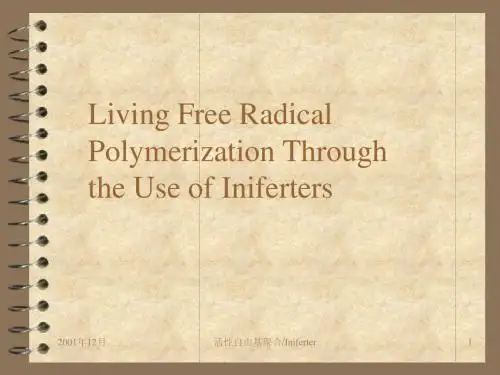
有机自由基电池作文英文回答:Organic free radical batteries are a new type of energy storage technology that has been gaining attention in recent years. Unlike traditional lithium-ion batteries, which rely on chemical reactions to store and release energy, organic free radical batteries use organic molecules with unpaired electrons, known as free radicals, to store and release energy.These batteries have several advantages overtraditional lithium-ion batteries. For one, they are much cheaper to produce, as the materials used in organic free radical batteries are abundant and inexpensive. Additionally, they are more environmentally friendly, as they do not contain any heavy metals or toxic chemicals. This makes them a more sustainable option for energy storage.Furthermore, organic free radical batteries have a longer lifespan compared to lithium-ion batteries. This is because the organic molecules used in these batteries are more stable and less prone to degradation over time. As a result, they can be charged and discharged more times before they start to lose their capacity.One of the most exciting aspects of organic freeradical batteries is their potential for high energy density. This means that they can store a large amount of energy in a small and lightweight package. This makes them ideal for use in portable electronics, electric vehicles, and even grid-scale energy storage systems.In addition to their high energy density, organic free radical batteries also have the potential for fast charging and discharging. This is because the free radicals in the organic molecules can quickly accept or release electrons, allowing for rapid energy transfer. This couldsignificantly reduce the charging time for electric vehicles and portable devices.Overall, organic free radical batteries show great promise as a next-generation energy storage technology.With their low cost, environmental friendliness, long lifespan, high energy density, and fast charging capabilities, they could revolutionize the way we store and use energy in the future.中文回答:有机自由基电池是一种近年来备受关注的新型能量储存技术。
“活性” 控制自由基聚合的研究进展陈小平 丘坤元(北京大学化学与分子工程学院高分子科学与工程系 北京100871)摘 要 本文对“活性” 控制自由基聚合的研究进展做了综述,并讨论了其主要聚合引发体系的应用现状和前景。
关键词 “活性”自由基聚合 引发转移终止剂 2,2,6,62四甲基212哌啶氮氧自由基 可逆加成2裂解链转移 原子转移自由基聚合中图分类号:O63115 文献标识码:A 文章编号:10052281X(2001)0320224210Study of“L iv i ng” Con trolled Rad ica l Poly m er iza tionChen X iaop ing Q iu K uny uan(D ep artm en t of Po lym er Science and Engineering,Co llege of Chem istry andM o lecu lar Engineering,Pek ing U n iversity,B eijing100871,Ch ina)Abstract T h is review focu ses on the recen t studies of“living” con tro lled radical po lym erizati on.T he app licati on s and the p ro spects of the i m po rtan t po lym erizati on system s are also discu ssed.Key words “living”radical po lym erizati on;in iferter;T E M PO;reversib le additi on2fragm en tati on chain tran sfer;atom tran sfer radical po lym erizati on 对聚合物分子的组成和结构进行精密控制是当前聚合物研究的重要领域[1]。
以下是一篇关于《Free Radical Biology and Medicine》的模板:标题:《Free Radical Biology and Medicine》研究模板摘要:本文旨在提供一个关于自由基生物学和医学研究的通用模板。
该模板涵盖了研究背景、目的、方法、结果和讨论等关键部分,可供研究人员在撰写相关论文时参考。
一、引言自由基是一类具有未成对电子的分子或原子,具有高度反应性,并参与多种生物过程。
然而,过多的自由基会导致氧化应激,从而损伤细胞结构和功能。
因此,对自由基生物学和医学的研究一直备受关注。
本文将从以下几个方面展开讨论:自由基的产生和清除、氧化应激与疾病的关系、抗氧化剂的作用等。
二、自由基的产生和清除自由基可以通过多种途径产生,如代谢过程中产生的中间产物、外界环境中的因素(如辐射、污染物)等。
为了维持细胞内环境的稳定,生物体具有一套完善的自由基清除机制,包括酶类和非酶类抗氧化剂。
这些抗氧化剂能够中和自由基,从而防止氧化应激的发生。
三、氧化应激与疾病的关系氧化应激是指细胞内自由基产生与清除失衡,导致自由基积累并对细胞造成损伤的过程。
许多研究表明,氧化应激与多种疾病的发生和发展密切相关,如心血管疾病、神经退行性疾病、癌症等。
因此,通过调节自由基的产生和清除,有望为这些疾病的治疗提供新的思路和方法。
四、抗氧化剂的作用抗氧化剂是一类能够中和自由基并减轻氧化应激的物质。
大量的研究表明,摄入适量的抗氧化剂可以降低慢性疾病的风险并改善健康。
目前常用的抗氧化剂包括维生素C、维生素E、β-胡萝卜素等。
此外,一些天然产物如多酚类化合物、黄酮类化合物等也表现出良好的抗氧化活性。
未来对抗氧化剂的研究将更加注重其在疾病预防和治疗中的潜在应用。
五、结论与展望本文简要概述了自由基生物学和医学的研究领域,包括自由基的产生和清除、氧化应激与疾病的关系以及抗氧化剂的作用。
随着科学技术的不断发展,对自由基生物学和医学的研究将越来越深入,有望为疾病的预防和治疗提供更多的理论支持和实践指导。